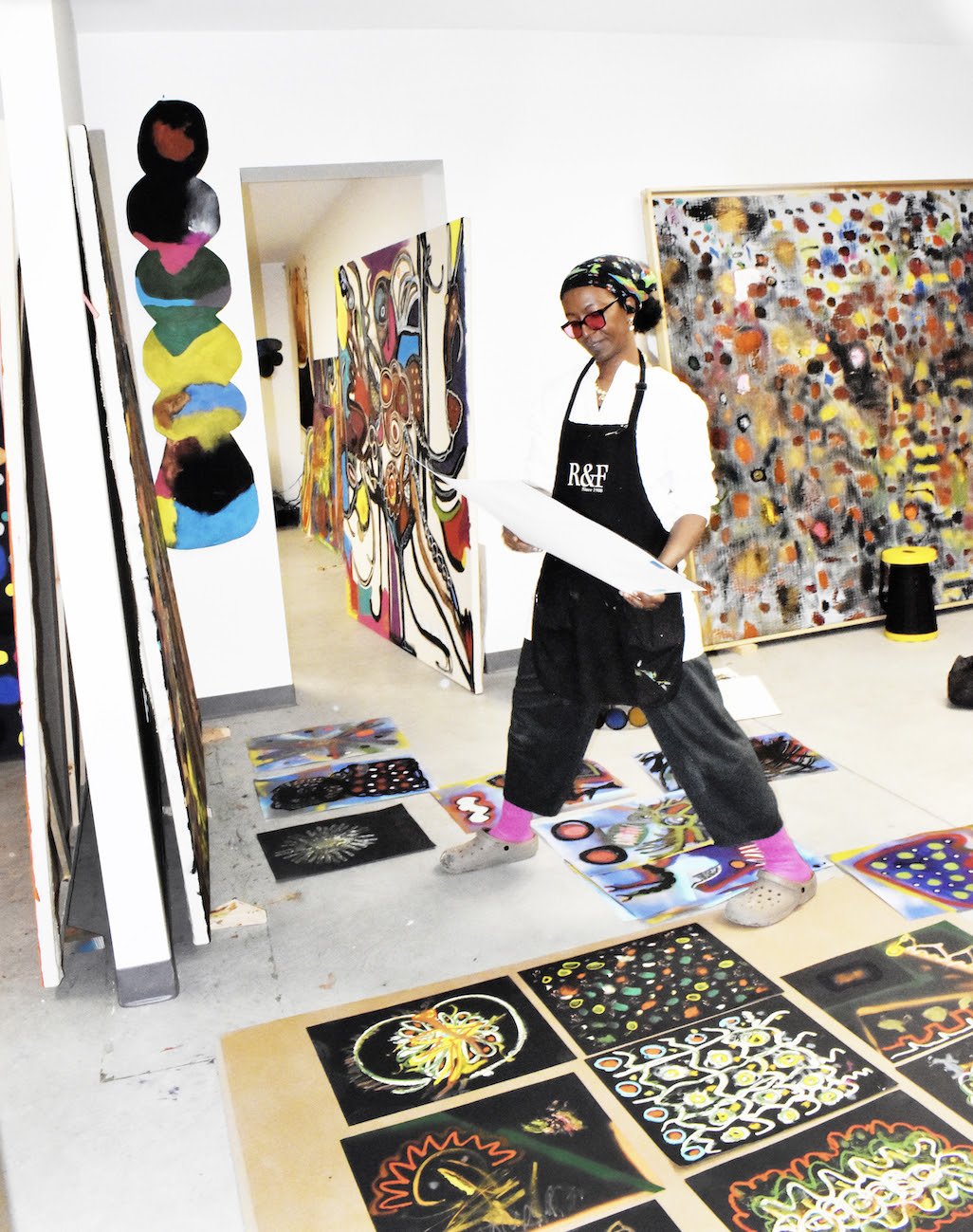Untitled
2019 - Textile (Textile)
147.32 x 68.58 cm
Alicia Henry
Out of simple materials, Alicia Henry creates enigmatic, somewhat troubled characters, which reveal her interest in the complexities and the contradictions surrounding familial relationships. The artist probes societal differences and how these variations affect individual and group responses to themes of beauty, the body, and broader issues of identity. Untitled explores these themes and addresses the processes through which women navigate such issues. Henry begins each sculpture by making preparatory drawings in her home studio. After completing her sketches, she begins working across an array of materials, including cotton, felt, leather, canvas, cotton, wool, linen, plastic to name a few. The choice of material will change according to which medium Henry deems best suited to the work at hand; her treatment of these materials lends the work its emotive quality. Untitled is a sculptural blend of textiles, acrylic, and paper that renders a highly tactile object. Drooped or empty sockets replace eyes, limbs feature voids, and faces are visibly sutured, absent, or lacking expression—alluding to physical pain and psychological trauma. At the same time, these figures generate deliberate presence moving the eye across the figure through formal exercises in color, line, and material. The figure is obscured by these layers of patterned and textured materials, creating a character that is expressive through more than their face alone. The artist once read that the state of being Black in is akin to being a Cold War spy—the ever-shifting loyalties; the constant heightened awareness of your surroundings; the palpable threat of violence from the enemy (which may or may not be your own state); the coded speech. Henry’s figure orients the viewer towards this sense of constant practiced deceptions, the masks worn for so long that the distinction between who one is and who one pretends to be ceases to exist.
Alicia Henry creates work that departs from Western ideas of portraiture, which denote a likeness or a construction of a subject. Instead, Henry’s figurative sculptures foreground the human figure in isolation, exploring metaphorical and formal connections between visibility and identity. Henry’s depictions of unidentifiable individuals are based on a range of composite references including but not limited by her own memories, African masks, paper-dolls, European clowning traditions, American minstrelsy and everyday life and events. Henry employs various techniques to make her representations including painting, collage, needlework, and leather tanning.
Colors:
Related works sharing similar palette

© » KADIST
Toyin Ojih Odutola
2015As she traces the same shape again and again, Ojih Odutola’s lines become darker and deeper, sometimes pushed to the point where their blackness becomes luminous...

© » KADIST
In New Mexico, Camacho investigated the reasons why the inhabitants of a village decided to change its name Truth or Consequences in the 50’s; with Group Marriage, an on-going project as part of the Amsterdam Spinoza Manifestation (2009), he petitions the Dutch parliament to open civil marriage to groups of citizens who would marry each other...

© » ART & OBJECT
Berlusconi Mull Over Future of His Art Collection | Art & Object Skip to main content Subscribe to our free e-letter! Webform Your Email Address Role Art Collector/Enthusiast Artist Art World Professional Academic Country USA Afghanistan Albania Algeria American Samoa Andorra Angola Anguilla Antarctica Antigua & Barbuda Argentina Armenia Aruba Ascension Island Australia Austria Azerbaijan Bahamas Bahrain Bangladesh Barbados Belarus Belgium Belize Benin Bermuda Bhutan Bolivia Bosnia & Herzegovina Botswana Bouvet Island Brazil British Indian Ocean Territory British Virgin Islands Brunei Bulgaria Burkina Faso Burundi Cambodia Cameroon Canada Canary Islands Cape Verde Caribbean Netherlands Cayman Islands Central African Republic Ceuta & Melilla Chad Chile China Christmas Island Clipperton Island Cocos (Keeling) Islands Colombia Comoros Congo - Brazzaville Congo - Kinshasa Cook Islands Costa Rica Croatia Cuba Curaçao Cyprus Czechia Côte d’Ivoire Denmark Diego Garcia Djibouti Dominica Dominican Republic Ecuador Egypt El Salvador Equatorial Guinea Eritrea Estonia Eswatini Ethiopia Falkland Islands Faroe Islands Fiji Finland France French Guiana French Polynesia French Southern Territories Gabon Gambia Georgia Germany Ghana Gibraltar Greece Greenland Grenada Guadeloupe Guam Guatemala Guernsey Guinea Guinea-Bissau Guyana Haiti Heard & McDonald Islands Honduras Hong Kong SAR China Hungary Iceland India Indonesia Iran Iraq Ireland Isle of Man Israel Italy Jamaica Japan Jersey Jordan Kazakhstan Kenya Kiribati Kosovo Kuwait Kyrgyzstan Laos Latvia Lebanon Lesotho Liberia Libya Liechtenstein Lithuania Luxembourg Macao SAR China Madagascar Malawi Malaysia Maldives Mali Malta Marshall Islands Martinique Mauritania Mauritius Mayotte Mexico Micronesia Moldova Monaco Mongolia Montenegro Montserrat Morocco Mozambique Myanmar (Burma) Namibia Nauru Nepal Netherlands Netherlands Antilles New Caledonia New Zealand Nicaragua Niger Nigeria Niue Norfolk Island Northern Mariana Islands North Korea North Macedonia Norway Oman Outlying Oceania Pakistan Palau Palestinian Territories Panama Papua New Guinea Paraguay Peru Philippines Pitcairn Islands Poland Portugal Puerto Rico Qatar Romania Russia Rwanda Réunion Samoa San Marino Saudi Arabia Senegal Serbia Seychelles Sierra Leone Singapore Sint Maarten Slovakia Slovenia Solomon Islands Somalia South Africa South Georgia & South Sandwich Islands South Korea South Sudan Spain Sri Lanka St...

© » KADIST
Natasha Wheat
2011Natasha Wheat’s Kerosene Triptych (2011) is composed of three images, one each from the digital files of the Library of Congress, the Smithsonian Institution, and the Field Museum tropical research archive...

© » KADIST
Kelly Sinnapah Mary
2021Notebook 10 , l ‘enfance de sanbras (The Childhood of Sanbras) series by Kelly Sinnapah Mary is a sequel to an earlier series by the artist titled Cahier d’un non retour au pays natal (2015)...

© » DAZED DIGITAL
The 50 best K-pop tracks of 2023 | Dazed â¬…ï¸ Left Arrow *ï¸âƒ£ Asterisk â Star Option Sliders âœ‰ï¸ Mail Exit Music Dazed Review 2023 From Jung Kook to NewJeans and aespa, we look back on the K-pop tracks that ruled the last 12 months Text Taylor Glasby 15 December 2023 If the past few years have been focused on expanding K-pop (more global tours and festivals, more English releases), then 2023 was the expansion of the industry’s biggest companies’ interests beyond K-pop itself...














